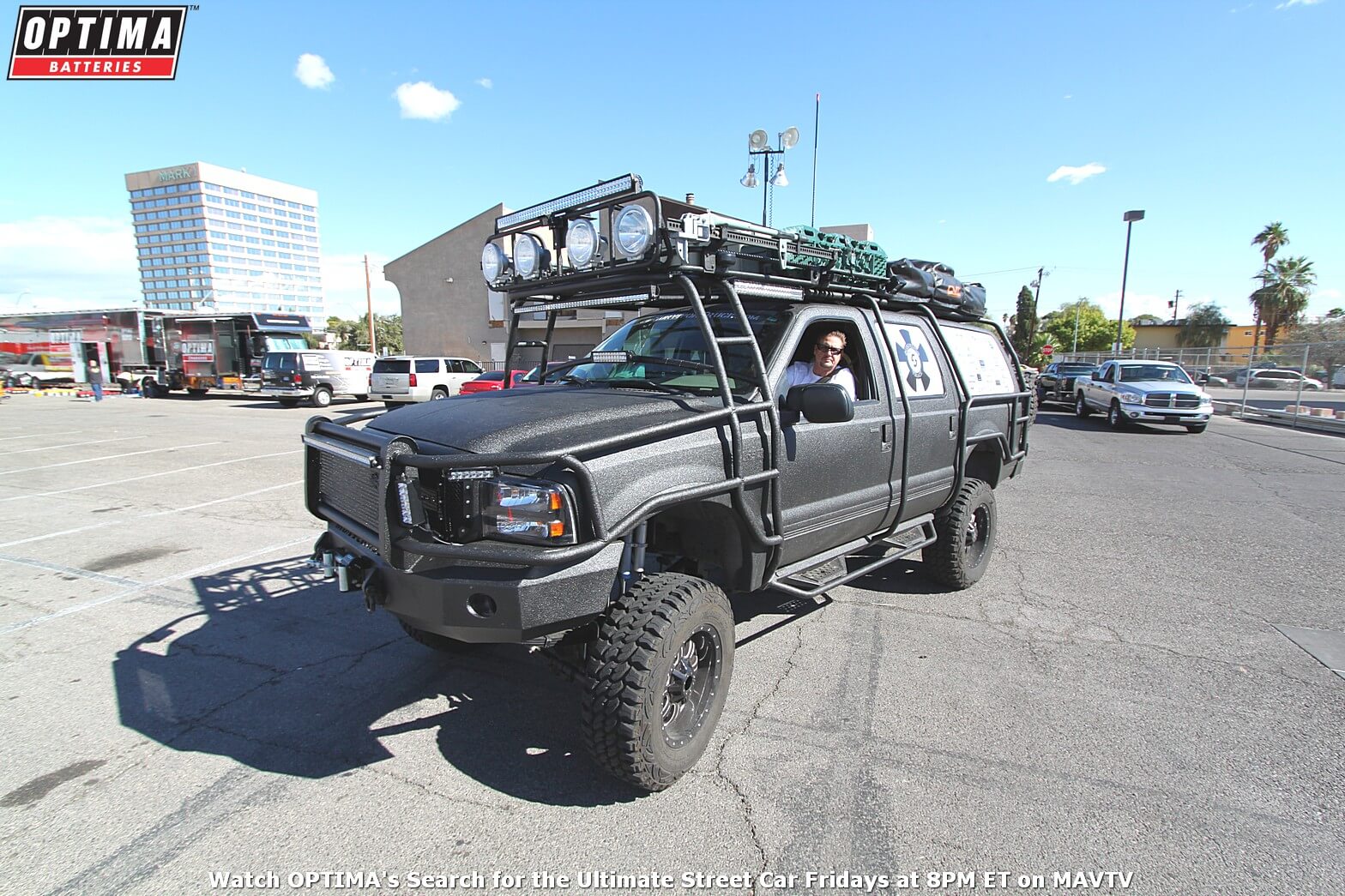Using An Air Compressor in a Vehicle

- Sponsor
- Location


Whenever we see vehicles like this Ford Excursion that rolled into the 2014 SEMA Show, our minds run wild with the possibilities of the accessories onboard this incredible machine. It could be anything and everything under the sun, from a monster sound system to everything needed for a bug-out vehicle or BOV as they are commonly known. Coincidentally, we recently received an e-mail in our "Ask Jim" mailbox about the use of air compressors in vehicles, which we thought was appropriate to answer here, especially after seeing this truck at SEMA.
Joe asks, "I have an air compressor mounted in my 2002 F-250 (7.3 diesel). My current batteries have reached the end of their life and didn't seem to last as long as I would've liked. The company says that their compressor requires high reserve capacity (120 minutes) and I'm wondering if you have any comparison between OPTIMA and other brands or any other thoughts or tips about my situation. I believe the compressor is run by a one-horsepower DC motor. I also have several other things drawing on my batteries, such as a two-way radio, that is said to draw up to 25 amps and a DC charger for power tools batteries."
It sounds like Joe has a lot going on in his truck and we checked the manufacturer website and they confirmed that they recommend batteries with at least 120 minutes of reserve capacity. Fortunately, the Battery Council International (BCI) offers ratings for batteries that help consumers understand the capability of batteries they are considering. While cranking amps or cold cranking amps might be an important consideration for engine starting applications, for accessories, reserve capacity (RC) is often a more important, but certainly not the only factor that should be considered when shopping for batteries. Our Group 31 batteries, whether someone selects the BLUETOP or YELLOWTOP, both offer 155 minutes of reserve capacity (RC).
That means these batteries (when fully-charged) can provide current for a 25-amp discharge for 155 minutes, before they reach 10.5 volts, which is considered fully-discharged. The compressor manufacturer indicates their product has an 80-amp draw, although they also note that draw exceeds normal usage. That means if you used it continuously for one hour, it would draw 80 amps, but most folks probably don't go anywhere near that usage.
However, the compressor manufacturer also notes that most vehicle alternators charge at a rate between 40-50 amps at idle, which may not be able to keep pace with usage. It is for that reason, that a battery with significant reserve capacity is recommended, as it will be called upon to pick up the electrical slack, if the vehicle's charging system is overwhelmed by demand. Keep in mind, in Joe's example, he's not just using a compressor, but also a two-way radio, a charging station for power tools and perhaps other electrical accessories, like lights, a cell phone charger, car radio, defroster, etc...
If that is the case, Joe's application may draw far more current than his alternator is capable of producing and his battery (or batteries) will be called upon to supply reserve power. If that is the case, here are a couple of important things to keep in mind-
- -Isolating accessory batteries may be a good idea in this application, as it will ensure there will always be enough power available in the starting battery to get the engine started and the vehicle back home (or to a safe location)
- -Accessory (or auxiliary) batteries should be designed for deep-cycle use, which would include our YELLOWTOP and BLUETOP batteries (with the light-gray cases). It's not enough to simply check the reserve capacity numbers on a battery, as starting batteries will see their effective reserve capacity drop off significantly after the first several cycles, while batteries designed for deep-cycle use can maintain far more reserve capacity for far more cycles.
- -The more deeply a battery is discharged, the fewer cycles it will be able to provide. While we often try to folks out of overbuying batteries based on cold cranking amps (especially if their application will never be used in winter months), but if someone is looking at an auxiliary battery application, having extra capacity can be a good thing.
- -Understand that applications like the one described in this blog are placing a tremendous strain on the vehicle's charging system, perhaps more than it can handle. Supplementing the alternator's output by fully re-charging batteries with a quality battery charger may be required at a minimum. Replacing the stock alternator with a high-output aftermarket alternator may be required.
- -If you start looking at upgrading your charging system and you've already upgraded your battery, don't leave yourself shortchanged with wiring that isn't up to the task. Google The Big Three Wiring to learn more about how quality wiring impacts the performance of your electrical system
- -While reserve capacity ratings are a great starting point for comparisons and understanding electrical capacity, they don't offer the full picture. Extreme temperatures (both hot and cold) can significantly impact battery performance and batteries that use 99.99% pure virgin lead (as OPTIMA uses exclusively in all our batteries) can perform better and last longer than batteries that use recycled lead.
